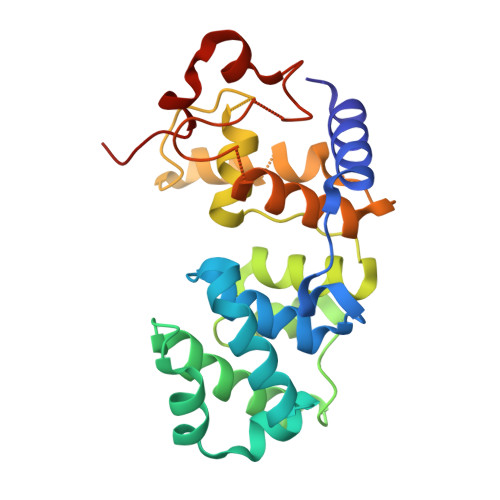Reaction intermediates in the catalytic mechanism of Escherichia coli MutY DNA glycosylase
Manuel, R.C., Hitomi, K., Arvai, A.S., House, P.G., Kurtz, A.J., Dodson, M.L., McCullough, A.K., Tainer, J.A., Lloyd, R.S.(2004) J Biol Chem 279: 46930-46939
- PubMed: 15326180
- DOI: https://doi.org/10.1074/jbc.M403944200
- Primary Citation of Related Structures:
1WEF, 1WEG, 1WEI - PubMed Abstract:
The Escherichia coli adenine DNA glycosylase, MutY, plays an important role in the maintenance of genomic stability by catalyzing the removal of adenine opposite 8-oxo-7,8-dihydroguanine or guanine in duplex DNA. Although the x-ray crystal structure of the catalytic domain of MutY revealed a mechanism for catalysis of the glycosyl bond, it appeared that several opportunistically positioned lysine side chains could participate in a secondary beta-elimination reaction. In this investigation, it is established via site-directed mutagenesis and the determination of a 1.35-A structure of MutY in complex with adenine that the abasic site (apurinic/apyrimidinic) lyase activity is alternatively regulated by two lysines, Lys142 and Lys20. Analyses of the crystallographic structure also suggest a role for Glu161 in the apurinic/apyrimidinic lyase chemistry. The beta-elimination reaction is structurally and chemically uncoupled from the initial glycosyl bond scission, indicating that this reaction occurs as a consequence of active site plasticity and slow dissociation of the product complex. MutY with either the K142A or K20A mutation still catalyzes beta and beta-delta elimination reactions, and both mutants can be trapped as covalent enzyme-DNA intermediates by chemical reduction. The trapping was observed to occur both pre- and post-phosphodiester bond scission, establishing that both of these intermediates have significant half-lives. Thus, the final spectrum of DNA products generated reflects the outcome of a delicate balance of closely related equilibrium constants.
Organizational Affiliation:
Sealy Center for Molecular Science and Department of Human Biological Chemistry and Genetics, University of Texas Medical Branch, Galveston, Texas 77555-1071, USA.

















